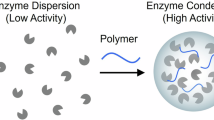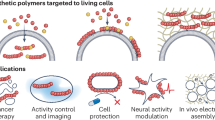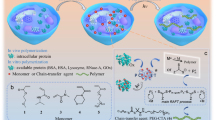Abstract
Engineering cell membranes for catalysis is challenging due to their inherent complexity. Here we introduce a polymeric strategy to overcome these challenges by chemically modifying cell membranes with catalytic polymers, enabling robust, recyclable and photoenzymatic catalysis. Through a one-step in situ atom transfer radical polymerization on living Escherichia coli cells, polymers are generated to protect the cells from environmental stressors while facilitating chemoenzymatic synthesis by integrating catalytic polymers with intracellular enzymes. As a proof of concept, a photoenzymatic cascade with an anthraquinone-based polymer and benzaldehyde lyase is demonstrated, converting benzyl alcohol into benzoin and achieving bioconversion yields that are 15 times higher than controls. Additionally, cells serve as large biological scaffolds for polymers, enabling recycling of macromolecular catalysts. A recyclable chemoenzymatic system incorporating an organometallic polymer with intracellular enzymes is also presented. Our versatile, straightforward approach offers a technology platform for engineering cell membranes for cascade synthesis, with broad implications for synthetic chemistry, polymer chemistry and biotechnology.

This is a preview of subscription content, access via your institution
Access options
Access Nature and 54 other Nature Portfolio journals
Get Nature+, our best-value online-access subscription
$32.99 / 30 days
cancel any time
Subscribe to this journal
Receive 12 digital issues and online access to articles
$119.00 per year
only $9.92 per issue
Buy this article
- Purchase on SpringerLink
- Instant access to full article PDF
Prices may be subject to local taxes which are calculated during checkout







Similar content being viewed by others
Data availability
All data supporting the findings of this study are available in the Article and the Supplementary Information or are available from the corresponding author upon reasonable request. Source data are provided with this paper.
References
Hothorn, M. et al. Catalytic core of a membrane-associated eukaryotic polyphosphate polymerase. Science 324, 513–516 (2009).
Suladze, S., Cinar, S., Sperlich, B. & Winter, R. Pressure modulation of the enzymatic activity of phospholipase A2, a putative membrane-associated pressure sensor. J. Am. Chem. Soc. 137, 12588–12596 (2015).
Hendrickx, A., Budzik, J., Young, S. & Schneewind, O. Architects at the bacterial surface—sortases and the assembly of pili with isopeptide bonds. Nat. Rev. Microbiol. 9, 166–176 (2011).
Hussain, M. S., Wang, Q. Z. & Viola, R. E. Engineering of a critical membrane-anchored enzyme for high solubility and catalytic activity. Arch. Biochem. Biophys. 703, 108870 (2021).
Mu, J. et al. A small-molecule FRET reporter for the real-time visualization of cell-surface proteolytic enzyme functions. Angew. Chem. Int. Ed. 53, 14357–14362 (2014).
Thomas, G. Furin at the cutting edge: from protein traffic to embryogenesis and disease. Nat. Rev. Mol. Cell Biol. 3, 753–766 (2002).
Seidah, N. G. & Prat, A. The biology and therapeutic targeting of the proprotein convertases. Nat. Rev. Drug Discov. 11, 367–383 (2012).
Lai, X., Wichers, H. J., S, L. M. & Dijkstra, B. W. Structure of human tyrosinase related protein 1 reveals a binuclear zinc active site important for melanogenesis. Angew. Chem. Int. Ed. 56, 9812–9815 (2017).
Grodd, W., Krägeloh-Mann, I., Petersen, D., Trefz, F. K. & Harzer, K. In vivo assessment of N-acetylaspartate in brain in spongy degeneration (Canavan’s disease) by proton spectroscopy. Lancet 336, 437–438 (1990).
Bohl, H. O., Shi, K., Lee, J. K. & Aihara, H. Crystal structure of lipid A disaccharide synthase LpxB from Escherichia coli. Nat. Commun. 9, 377 (2018).
Gómez, M. S. et al. The oxidative fermentation of ethanol in Gluconacetobacter diazotrophicus is a two-step pathway catalyzed by a single enzyme: alcohol-aldehyde dehydrogenase (ADHa). Int. J. Mol. Sci. 16, 1293–1311 (2015).
Yakushi, T. & Matsushita, K. Alcohol dehydrogenase of acetic acid bacteria: structure, mode of action, and applications in biotechnology. Appl. Microbiol. Biotechnol. 86, 1257–1265 (2010).
Yang, H. et al. Molecular biology: fantastic toolkits to improve knowledge and application of acetic acid bacteria. Biotechnol. Adv. 58, 107911 (2022).
Fan, L. H., Zhang, Z. J., Yu, X. Y., Xue, Y. X. & Tan, T. W. Self-surface assembly of cellulosomes with two miniscaffoldins on Saccharomyces cerevisiae for cellulosic ethanol production. Proc. Natl Acad. Sci. USA 109, 13260–13265 (2012).
Tanaka, T. & Kondo, A. Cell surface engineering of industrial microorganisms for biorefining applications. Biotechnol. Adv. 33, 1403–1411 (2015).
Chen, K. & Arnold, F. H. Engineering new catalytic activities in enzymes. Nat. Catal. 3, 203–213 (2020).
Lee, S. Y., Choi, J. H. & Xu, Z. Microbial cell-surface display. Trends Biotechnol. 21, 45–52 (2003).
Smith, G. P. Filamentous fusion phage: novel expression vectors that display cloned antigens on the virion surface. Science 228, 1315–1317 (1985).
Charbit, A., Boulain, J. C., Ryter, A. & Hofnung, M. Probing the topology of a bacterial membrane protein by genetic insertion of a foreign epitope; expression at the cell surface. EMBO J. 5, 3029–3037 (1986).
Richins, R. D., Kaneva, I., Mulchandani, A. & Chen, W. Biodegradation of organophosphorus pesticides by surface-expressed organophosphorus hydrolase. Nat. Biotechnol. 15, 984–987 (1997).
Jin, Z. et al. Combined utilization of lipase-displaying Pichia pastoris whole-cell biocatalysts to improve biodiesel production in co-solvent media. Bioresour. Technol. 130, 102–109 (2013).
Boder, E. T. & Wittrup, K. D. Yeast surface display for screening combinatorial polypeptide libraries. Nat. Biotechnol. 15, 553–557 (1997).
Szponarski, M., Schwizer, F., Ward, T. R. & Gademann, K. On-cell catalysis by surface engineering of live cells with an artificial metalloenzyme. Commun. Chem. 1, 84 (2018).
Schmid, A. et al. Industrial biocatalysis today and tomorrow. Nature 409, 258–268 (2001).
Stepankova, V. et al. Strategies for stabilization of enzymes in organic solvents. ACS Catal. 3, 2823–2836 (2013).
Zhang, N., Sun, Z. & Wu, C. Artificial enzymes combining proteins with proline polymers for asymmetric aldol reactions in water. ACS Catal. 12, 4777–4783 (2022).
Chi, Y., Scroggins, S. T., Boz, E. & Fréchet, J. M. J. Control of aldol reaction pathways of enolizable aldehydes in an aqueous environment with a hyperbranched polymeric catalyst. J. Am. Chem. Soc. 130, 17287–17289 (2008).
Liu, F., Kong, W., Qi, C., Zhu, L. & Xiao, F. S. Design and synthesis of mesoporous polymer-based solid acid catalysts with excellent hydrophobicity and extraordinary catalytic activity. ACS Catal. 2, 565–572 (2012).
Huang, K., Zhang, J. Y., Liu, F. & Dai, S. Synthesis of porous polymeric catalysts for the conversion of carbon dioxide. ACS Catal. 8, 9079–9102 (2018).
Sun, Z., Hübner, R., Li, J. & Wu, C. Artificially sporulated Escherichia coli cells as a robust cell factory for interfacial biocatalysis. Nat. Commun. 13, 3142 (2022).
Park, J. H. et al. A cytoprotective and degradable metal–polyphenol nanoshell for single-cell encapsulation. Angew. Chem. Int. Ed. 53, 12420–12425 (2014).
Kim, J. Y. et al. Cytocompatible polymer grafting from individual living cells by atom-transfer radical polymerization. Angew. Chem. Int. Ed. 55, 15306–15309 (2016).
Magennis, E. P. et al. Bacteria-instructed synthesis of polymers for self-selective microbial binding and labelling. Nat. Mater. 13, 748–755 (2014).
Niu, J. et al. Engineering live cell surfaces with functional polymers via cytocompatible controlled radical polymerization. Nat. Chem. 9, 537–545 (2017).
Song, R. B. et al. Living and conducting: coating individual bacterial cells with in situ formed polypyrrole. Angew. Chem. Int. Ed. 56, 10516–10520 (2017).
Laskar, P., Varghese, O. P. & Shastri, V. P. Advances in intracellular and on-surface polymerization in living cells: implications for nanobiomedicines. Adv. Nanobiomed. Res. 3, 2200174 (2023).
Pan, J. et al. A single-cell nanocoating of probiotics for enhanced amelioration of antibiotic-associated diarrhea. Nat. Commun. 13, 2117 (2022).
Smith, P. N., Mao, L., Sinha, K. & Russell, A. J. Organophosphate detoxification by membrane-engineered red blood cells. Acta Biomater. 124, 270–281 (2021).
Safarova, Y. et al. Mesenchymal stem cells coated with synthetic bone-targeting polymers enhance osteoporotic bone fracture regeneration. Bioengineering 7, 125 (2020).
Clafshenkel, W. P. et al. The effect of covalently-attached ATRP-synthesized polymers on membrane stability and cytoprotection in human erythrocytes. PLoS One 11, e0157641 (2016).
D’Souza, S. et al. Engineering of cell membranes with a bisphosphonate-containing polymer using ATRP synthesis for bone targeting. Biomaterials 35, 9447–9458 (2014).
Teramura, Y. & Iwata, H. Cell surface modification with polymers for biomedical studies. Soft Matter 6, 1081–1091 (2010).
Teramura, Y., Kaneda, Y. & Iwata, H. Islet-encapsulation in ultra-thin layer-by-layer membranes of poly(vinyl alcohol) anchored to poly(ethylene glycol)-lipids in the cell membrane. Biomaterials 28, 4818–4825 (2007).
Sun, Z., Glebe, U., Charan, H., Böker, A. & Wu, C. Enzyme–polymer conjugates as robust pickering interfacial biocatalysts for efficient biotransformations and one-pot cascade reactions. Angew. Chem. Int. Ed. 57, 13810–13814 (2018).
Wang, J. S. & Matyjaszewski, K. Controlled/‘living’ radical polymerization. atom transfer radical polymerization in the presence of transition-metal complexes. J. Am. Chem. Soc. 117, 5614–5615 (1995).
Matyjaszewski, K. & Tsarevsky, N. V. Macromolecular engineering by atom transfer radical polymerization. J. Am. Chem. Soc. 136, 6513–6533 (2014).
Vargason, A. M., Santhosh, S. & Anselmo, A. C. Surface modifications for improved delivery and function of therapeutic bacteria. Small 16, 2001705 (2020).
Li, D. et al. Extended-resolution structured illumination imaging of endocytic and cytoskeletal dynamics. Science 349, aab3500 (2015).
Sahl, S. J., Hell, S. W. & Jakobs, S. Fluorescence nanoscopy in cell biology. Nat. Rev. Mol. Cell Biol. 18, 685–701 (2017).
Kraus, F. et al. Quantitative 3D structured illumination microscopy of nuclear structures. Nat. Protoc. 12, 1011–1028 (2017).
Boulos, L., Prévost, M., Barbeau, B., Coallier, J. & Desjardins, R. LIVE/DEAD BacLight: application of a new rapid staining method for direct enumeration of viable and total bacteria in drinking water. J. Microbiol. Methods 37, 77–86 (1999).
Köhler, V. et al. Synthetic cascades are enabled by combining biocatalysts with artificial metalloenzymes. Nat. Chem. 5, 93–99 (2013).
Zhang, W., Gacs, J., Isabel, W. C. E. & Hollmann, F. Selective photooxidation reactions using water-soluble anthraquinone photocatalysts. ChemCatChem 9, 3821–3826 (2017).
Imlay, J. A. The molecular mechanisms and physiological consequences of oxidative stress: lessons from a model bacterium. Nat. Rev. Microbiol. 11, 443–454 (2013).
Acknowledgements
We are grateful for financial support from the Independent Research Fund Denmark within the framework of the Sapere Aude leader programme (9064-00062B, C.W.). We also thank the Novo Nordisk Foundation (NNF21OC0071661, C.W.), the Carlsberg Foundation (CF22-1008, C.W.), the S.C. VAN foundation (J.N.) and the National Key R&D Program of China (2023YFA0913600, Z.S.) for their generous funding. We are grateful to Enzymicals AG for providing the plasmid of ATA, to A. Worbs for performing SEM and to C. He (Sichuan University) for TEM and EDXS measurements. We would like to acknowledge the assistance of the core facility BioSupraMol (FU Berlin), C. Hudziak (FU Berlin) for GPC measurement and T. Frickmann and D. E. Canfield (University of Southern Denmark) for ICP-MS analysis. The use of the HZDR Ion Beam Center TEM facilities is acknowledged. Cryo-TEM image acquisition and image analyses were performed at the Institute of Chemistry and Biochemistry, Electron Microscopy Research Center (FU Berlin). Fluorescence image acquisition and image analyses were performed at the Danish Molecular Biomedical Imaging Center (DaMBIC, University of Southern Denmark), supported by the Novo Nordisk Foundation (NNF18SA0032928, M.F.E.).
Author information
Authors and Affiliations
Contributions
C.W. conceptualized and supervised the project. J.N. performed the experiments. Z.S. provided experimental guidance and scientific discussion. R.H. performed SEM-based data analysis. M.F.E. conducted SIM and STED measurements. M.D. performed cryo-TEM and relevant data analysis. H.K. provided guidance and supervision related to the microbiological work. C.W., J.N. and Z.S. wrote the paper.
Corresponding author
Ethics declarations
Competing interests
The authors declare no competing interests.
Peer review
Peer review information
Nature Catalysis thanks Nico Bruns, Florian Rudroff and the other, anonymous, reviewer(s) for their contribution to the peer review of this work.
Additional information
Publisher’s note Springer Nature remains neutral with regard to jurisdictional claims in published maps and institutional affiliations.
Supplementary information
Supplementary Information
Supplementary methods, Table 1, Figs. 1–37 and Notes 1 and 2.
Supplementary Data
Raw NMR data.
Source data
Source Data Fig. 2
Statistical source data.
Source Data Fig. 3
Statistical source data.
Source Data Fig. 4
Statistical source data.
Source Data Fig. 6
Statistical source data.
Source Data Fig. 7
Statistical source data.
Rights and permissions
Springer Nature or its licensor (e.g. a society or other partner) holds exclusive rights to this article under a publishing agreement with the author(s) or other rightsholder(s); author self-archiving of the accepted manuscript version of this article is solely governed by the terms of such publishing agreement and applicable law.
About this article
Cite this article
Ning, J., Sun, Z., Hübner, R. et al. Engineering living cells with polymers for recyclable photoenzymatic catalysis. Nat Catal 7, 1404–1416 (2024). https://doi.org/10.1038/s41929-024-01259-5
Received:
Accepted:
Published:
Issue date:
DOI: https://doi.org/10.1038/s41929-024-01259-5
This article is cited by
-
Polymer-decorated bacteria for cascade catalysis
Nature Catalysis (2024)



